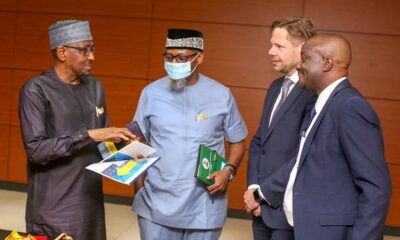Opinion
Imperatives Of JAMB’s Benchmark
Recently, Joint Admission and Matriculation Board, JAMB, the statutory agency for regulating admissions into tertiary institutions in the country, reviewed its benchmark pegging the minimum requirement to 120 points. The development signaled thumbs-up and down. Some argued that the development will finally reduce the standard of education to a zero level and therefore called for immediate reversal to the status quo.
However, those making reservations seemingly failed to call to mind or perhaps, unaware that a good number of students from the well-to-do homes, over time rarely meet up with the prescribed cut-off marks, yet first to appear on admission lists. Don’t ask me how. However, candidates from the less-privileged homes who through hard work and diligence met the required cut-off marks are denied admissions. On a second look, the critics also forgot that those in part-time in the same universities offering same programmes do not participate in Universities Matriculation Examinations (UME) apart from few that are strictly on full-time studies like Medicine, Law and Engineering.
Numerically, this abnormality originally earmarked for good, has frustrated a lot from getting admissions. On the third, the opponents forgot that admission into universities does not guarantee graduation but good performance. The increasing number of able candidates, most from the low-class roaming the streets over JAMB excesses, ought to raise some concerns.
More worrisome is situations where factually competent candidates are hindered for less competent ones in the name of Vice Chancellors’ list, Registrar’s lists, HOD’s lists, senators lists and even other rooms’ lists. Indeed, the elites in conjunction with JAMB have played enough Jamborees with leaders of tomorrow. Some brilliant O’level school leavers had after several consecutive years of patronizing JAMB with neither benefits nor interests yielded; some three, five and even sevenyears, abandoned wonderful dreams of furthering their education, due to shame.
The new development will inevitably open wider doors for tertiary education and eliminate the corruption thriving in universities, and at the same time add values to the citizenry keenly interested in education. As long as lecturers adopt the standard operating system by teaching, examining and clearing students through marking schemes instead of the usual bedroom examinations for opposite sex, hire-purchase or cash ‘n’ carry results for the rich; the new admission template will not be compromised.
The onus therefore shifts to the university dons to strictly adhere to the scheme of work accordingly rather than selfish interests.
The Federal Ministry of Education should put adequate mechanism in place to ensure that lecturers are optimistic in service delivery. Nevertheless, the new benchmark will not discontinue the sequential best to good preferences.
In similar vein, the National Council on Education, NCE recently deflated the rumours on exclusion of Christian Religious Studies. Ditto on History viewed as misadventures on account of endless aggressions and hate speeches from virtually all the ethnic groups in the country in recent times.
Factually, the 9-year Basic Education Curriculum, BEC originated from Chief Olusegun Obasanjo’s administration in 2008. However, owing to commotion over plethora of subjects, they were rearranged by the previous administration in 2012 with the then Minister of Education, Professor Ruqayyatu Ahmed Rufa’i and Minister of State for Education, Barr. NyesomWike, now Rivers State governor, alongside Professor Godswill Obioma as the then Executive Secretary, Nigerian Educational Research and Development Council, NERDC.The rearrangement led to grouping of the five subjects; Christian Religious Studies, Islamic Religious Studies, Social Studies, Civic Education and Security Education under the Religion and National Values, RNV as shown in the National Policy on Education, 6th edition (2014) for basic education (primary 1 to junior secondary 3) at page 10 – 13.
President Muhammadu Buhari’s administration implemented the UBE with a slight review through the present Minister of Education, MallamAdamuAdamu in 2016, which merely disarticulated History from Social Studies to stand separately as two subjects, and nothing more. The development resulting from consultations was to engage children deeply in Social Studies and History rather than the shallow knowledge that merely recites public office holders and cities as thoroughly-crafted panacea over the hurly-burlies in the contemporary age.
Similarly, French language alleged to be elective with the ‘Islamic Arabic studies’; alien to the curriculum, is clearly a compulsory subject from Primary 4 as provided in Section 2 (23) 7 at page 13 of the National Policy on Education. Furthermore, Arabic language remains optional since 2008, and exclusively for those willing to have knowledge of the language.
Commendably, NCE reiterated its position in line with the 9-year BEC policy which emphatically provides, “no child should be coerced or compelled to learn or taught any religious studies curriculum in school but one out of the two that restrictively relates to the belief system professed by the child and his/her parents”.
Thus, no child is, however, under any compulsion to offer religious studies other than that of the parents in public schools. Of course, if in private schools, a different ball game with respect to‘volenti non fit injuria’ (to a willing person, no harm is done). Ditto missionary schools, since they cannot teach the doctrines of other religion. Overall, the Federal Government perspicaciously utilized the Basic Education Curriculum to tackle unemployment and at the same time impacting positively on leaders of tomorrow.
Umegboro is a public affairs analyst.
Carl Umegboro
Opinion
The Girl Who Didn’t Dance
Opinion
Tradition or idolatry? The Debate Over Nhe-Ajoku

Opinion
Fubara’s Strategic Masterstroke

-

 News3 days ago
News3 days agoFG Suspends Planned 15% Import Duty On PMS, Diesel
-
Sports3 days ago
Bisi Open Championship: Coach Attributes Victory To Hard Work
-

 Politics3 days ago
Politics3 days agoOsun 2026: Why Adeleke Is Searching For Platform To Contest Poll – PDP Chieftain
-
News2 days ago
Tinubu Mourns Newswatch Co-Founder, Agbese
-
Nation4 days ago
HMSPR Oil, NCDMB, NIMASA, Stakeholders Praise Tamrose for Phenomenal Growth, Exemplary Local Content Capacity Building and Financial Fidelity …Pledge Increased Financial and Institutional Support for Indigenous Companies
-
Business3 days ago
2,000 Women Entrepreneurs Set To Receive PINL Business Support For Host Communities
-
Sports2 days ago
New W.W. Whyte Tournament Focuses On Talent Discovery – Engr. Alabere
-
News3 days ago
Nigeria Ready For 32.2 % Emission Reduction By 2035 – NCCC D-G

